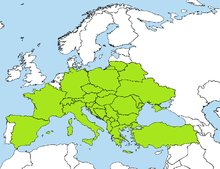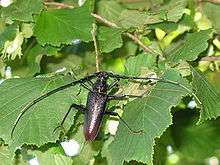Cerambyx cerdo
Cerambyx cerdo, commonly known as the great capricorn beetle, is a species of beetle in family Cerambycidae. It is widespread in Algeria, Armenia, Austria, Azerbaijan, Belarus, Bulgaria, Croatia, the Czech Republic, France, Georgia, Germany, Hungary, Iran, Italy, Moldova, Morocco, Portugal, Poland, Romania, Serbia, Slovakia, Spain, Switzerland, Tunisia, Turkey, Nepal, Ukraine, and the United Kingdom.[1]
| Cerambyx cerdo | |
|---|---|
.jpg) | |
| Male (left) and Female (right) | |
| Scientific classification | |
| Kingdom: | Animalia |
| Phylum: | Arthropoda |
| Class: | Insecta |
| Order: | Coleoptera |
| Family: | Cerambycidae |
| Genus: | Cerambyx |
| Species: | C. cerdo |
| Binomial name | |
| Cerambyx cerdo | |
 | |
| Distribution of C. Cerdo | |
| Synonyms | |
| |
Description
This beetle measures between 41 and 55 mm in body length and is among the largest of the European beetle species. It has an elongated, robust body and, like all members of the longhorn family, it has long antennae. In males, these thread-like antennae are longer than the body, but in females they are only as long as the hard wing cases (the elytra). The legs and body are black, except for the elytra which are reddish-brown towards the tips.[2]
Photogallery
 Male specimen
Male specimen- Female specimen
.jpg) Front view of a female
Front view of a female
References
- World Conservation Monitoring Centre (1996). "Cerambyx cerdo". The IUCN Red List of Threatened Species. IUCN. 1996: e.T4166A10503380. doi:10.2305/IUCN.UK.1996.RLTS.T4166A10503380.en. Retrieved 27 December 2017.
- ARKive
External links


